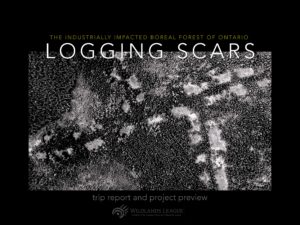This summer I drove, biked and hiked thousands of kilometres of dusty logging roads in northwestern Ontario, camping in the heart of Canada’s boreal forest. I was there to visit old clearcuts – areas of forest where industrial logging has occurred. Areas where 2x4s, newspapers, and toilet paper in North America have come from for generations.
With my work, I spend a lot of deal of time poring over satellite images, and out the windows of small planes flying over this vast boreal landscape. It’s a carbon-rich blanket of sturdy coniferous-dominated forest, truly a globally significant treasure. But, a peculiar pattern continues to stare back at me. It is a startling pattern of… logging scars.
So? We probably can’t extract resources without leaving some mark. And, we are assured by our logging industry and their regulators that trees logged here are entirely renewed. So, are these scars just an interesting… signature in the forest? I didn’t think so, and I had to find out.
Now, after two summers of fieldwork, I am more confident that these scars represent a more expansive, longer lasting, and deeply wasteful legacy.
I am attaching some trip photos and a quick summary of this project: to better understand ongoing logging impacts, by glimpsing back in time. To where logging 20-30 years ago has taken the forest today.
















